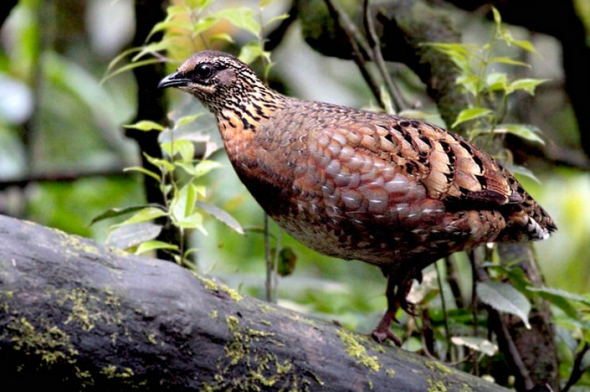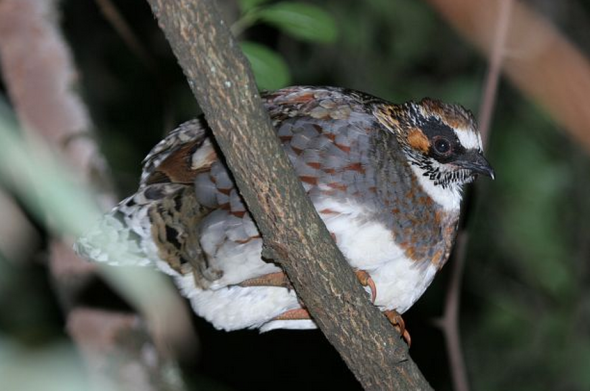Endangered Species Friday - Arborophila rufipectus
Endangered Species Friday - Arborophila rufipectus
This Friday’s endangered species I document on yet another species of bird that’s sadly been added to International Animal Rescue Foundation’s Bird Watch Project. Scientifically identified as the Arborophila rufipectus and commonly known as the Sichuan Partridge the species is listed as endangered - nearing extinction. (Image adult Sichuan Partridge). Listed as a nationally-protected species in China. In 1998, it was recorded in Mabian Dafengding Nature Reserve, where there was estimated to be 192 km2 of potentially suitable habitat.
Identified by Dr Boulton in 1932 the species falls into the phasianidae family. A. rufipectus is restricted to its endemic range of China from which its known to inhabit the south-central Sichuan, China with some sketchy reports of the species documented within Yunnan.
Reporting from Singapore where one of five of our Asiatic Bird Watch Projects are situated, environmental teams stipulated from their visits into China within the past fourteen months, no current camera trappings of the species have been recorded within its native range, or ranges where past census’s have been undertaken.
Furthermore the team exhausted all other searches by widening the search covering a total of 2,100 km2. Observations were undertaken in key areas where it was deemed the Sichuan Partridge may be inhabiting taking into consideration food sources, areas of forest that hadn’t been logged while communicating to local hunters, poachers and, locals within the area.
Graduate Lee Won - International Animal Rescue Foundation’s Bird Watch Project CEO stated “We covered an area over the 1,700 km2 setting camera traps within Sichuan and Yannan (2014-2015). The traps were in place for exactly 14 months of which not one single individual or even a pair of Sichuan Partridges were recorded, which brings me and the team to the conclusion that its quite possible extinctions have already occurred, western environmental organisations have as yet to catch up on this data”.
Lee Won and the team that are working within extreme environments stated that vast deforestation is increasing within the birds natural environment of which enforcement and environmental protection remains to be seen. “If Chinese authorities and the Department of Forests and Environment do not protect the Yunnan forests there will be little flora or fauna remaining within this area by 2030” Won stated. The situation is more than dire, its tragic Lee confirmed.
With populations still recorded as “decreasing” the last known census recorded from 1996-1997 recorded an “estimated” total of 806 to 1,772 mature individuals (final count stood at 1,500-3,749). So from Lee Won and his teams evaluations its quite possible that extinction has occurred of which evidence will be submitted in due course to the International Union for the Conservation of Nature (IUCN).
Dai bo (2007) stated that new sightings of the Sichuan Partridges have been recorded within Laojunshan Nature Reserve numbering around eighty four individuals, these sightings were recorded from 1998-2002. Kim Won’s Bird Watch Project will be making their way to the Laojunshan Nature Reserve in the next few weeks in the hope to locate any evidence of the birds present occupation within the area. Unfortunately we remain skeptical. As explained from 1996/7 population estimate is likely to be too low, hence it is best placed in the band 1,000-2,499 mature individuals. This equates to 1,500-3,749 individuals in total, rounded here to 1,500-4,000 individuals. (Source IUCN).
Males are territorial and monogamous. Males will stay away from the females before mating and during the incubation period. At all other times, males will roost alongside the females. While females are brooding on the ground, the males will sit near the ground for two weeks and then leave to roost elsewhere. The breeding season is late March while the hatching season is mid-May through mid-July. Once paired, males will guard females 24 hours a day.
Image: Sichuan Partridge fledgling.
When it comes to the general breeding and habitat locations for the partridge, it prefers more local areas far from direct disturbances from human contact. Males have three types of one-syllable call, which are a crowing call, courtship call, and preserving territory call. The syllable duration is significantly different between calls, but the difference of main peak frequency was not significantly different. The vocal behaviors will benefit to preserve mates and avoid the predator pressure so the population could last longer.
The Sichuan partridge lives mostly in southern Sichuan Province, in south-west China. It prefers primary and older planted secondary broadleaf forests, rather than one with human activity close by. Prefers a dense canopy and more open understory. The major habitats (in ranking order) are Primary Broadleaf Forest, old replanted Broadleaf Forest, Degraded Forest, and scrub. It prefers thick shrubs for roosting.
Recent work on the species in Laojunshan Nature Reserve found that the species occurred in secondary broadleaf forest but not in settlements, coniferous plantations or farmland [please note there remains no date regarding recent work]. The same study found that birds typically occurred between 1400 and 1800m above sea level in the reserve, and mostly on gently sloping ground close to water sources. [undated with citation required].
Major Threats
Until recently the main threat was habitat destruction through commercial clear-felling of primary forest, as most remaining primary broadleaved forest within its known range was at risk from logging within 20-25 years. In 1998, a government-imposed ban on logging in the upper Yangtze Basin led to a complete halt in deforestation throughout its range.
There is now a major forest plantation scheme in operation aiming to re-forest ridges and steeper slopes. In general though, habitat is still declining. In some areas, forest is still being cleared for agriculture or illegally logged, although this has been “alleged to be on a small scale”. Many people enter the forest to collect bamboo shoots, firewood and medicinal plants in spring and early autumn, which creates substantial disturbance during the breeding season, and additional disturbance is caused by livestock either grazing in, or moving through, the forest.
The species is also illegally hunted. Hydroelectric schemes and the resulting reservoirs in the valleys below its mountain forest habitat cause indirect future threats as the people they displace will be moved to higher locations in close proximity to the remaining forest, putting it under increased pressure.
Further assessments on the species and other endemic species will continue through to next year. I hope to update you on my teams current goals and objectives.
Thank you for reading.
Dr Jose C. Depre.
www.speakupforthevoiceless.org
Please support the organisation Say No To Dog Meat this Malbok Festival from July to August 2015.




